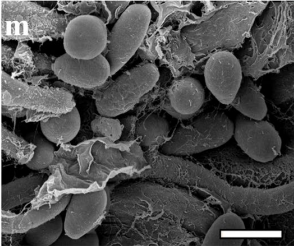The Challenger Deep forms the deepest part of the Mariana Trench, reaching 10 971 m below sealevel. Curiously, recent studies have shown that the hadal depths of the oceans (areas more than 6 km deep) have a higher microbial carbon turnover than occurs at abyssal depths, between 4 km and 6 km below the surface. This has been supported by metagenomic studies which have shown significantly more genes coding for carbohydrate-active enzymes and peptidase are being expressed at these depths. This has led microbiologists to take an interest in the organisms living in the sediments of the deepest ocean trenches.
In a paper published in the journal Antonie van Leeuwenhoek on 28 February 2024, Hongbo Zhou of the School of Minerals Processing and Bioengineering and the Key Laboratory of Biometallurgy at Central South University, Liting Xu and Wenxian Liu, also of the School of Minerals Processing and Bioengineering at Central South University, Kaiwen Ta of the Institute of Deep-Sea Science and Engineering of the Chinese Academy of Sciences, Xincun Wang of the State Key Laboratory of Mycology at the Institute of Microbiology of the Chinese Academy of Sciences, Jianwei Guo of the College of Agronomy and Life Sciences at Kunming University, Wenxi Luo, Zhiyuan Peng, and Qiaoni Huang, again of the School of Minerals Processing and Bioengineering at Central South University, and Yuguang Wang, once again of the School of Minerals Processing and Bioengineering and the Key Laboratory of Biometallurgy at Central South University, describe a new species of Ascomycote Fungi from the Challenger Deep.
The new species is described on the basis of two strains isolated from samples collected by the Research Vessel Tan Suo Yi Hao in September 2019, from a depth of 10 063 m below sealevel. A genetic analysis of these strains suggests that they belong to the same species, and, surprisingly, that that species is a member of the genus Talaromyces, which mostly comprises terrestrial moulds, forming a sister taxon to a clade which includes Talaromyces trachyspermus, which is a serious commercial pest species, frequently infecting packaged fruit juices, and Talaromyces assiutensis, which is found growing within the leaves of Mangroves around the South China Sea. The new species is named Talaromyces sedimenticola, in reference to the environment where it was found.
While morphologically similar, and genetically close, to other members of the genus Talaromyces, Talaromyces sedimenticola shows some remarkable physiological traits, which mark it out as distinctive. It could be grown at temperatures of between 4°C and 50°C, unlike most Talaromyces species, which typically grow between about 28°C and 40°C. It could also survive and grow over a far wider pH range than any other species within the genus, pH 1.5-12, whereas other Talaromyces species could only survive in the pH range 4-8, with the exception of Talaromyces aculeatus, a widespread soil-dwelling form, which can survive over the range pH 1-7. Talaromyces sedimenticola is also remarkably halotollerant, able to flourish on media with 0-14% sodium chloride (weight over volume). More curiously, Talaromyces sedimenticola was unable to metabolise sucrose, tryptone, or monobasic potassium phosphate, all of which can be utilised by other members of the genus, although it was able to utilise other common foodstuffs, such as glucose, maltose, lactose, xylose, soluble starch, glycerol, peptone, ammonium sulphate, potassium phosphate, potassium chloride, and magnesium sulphate.
See also...










